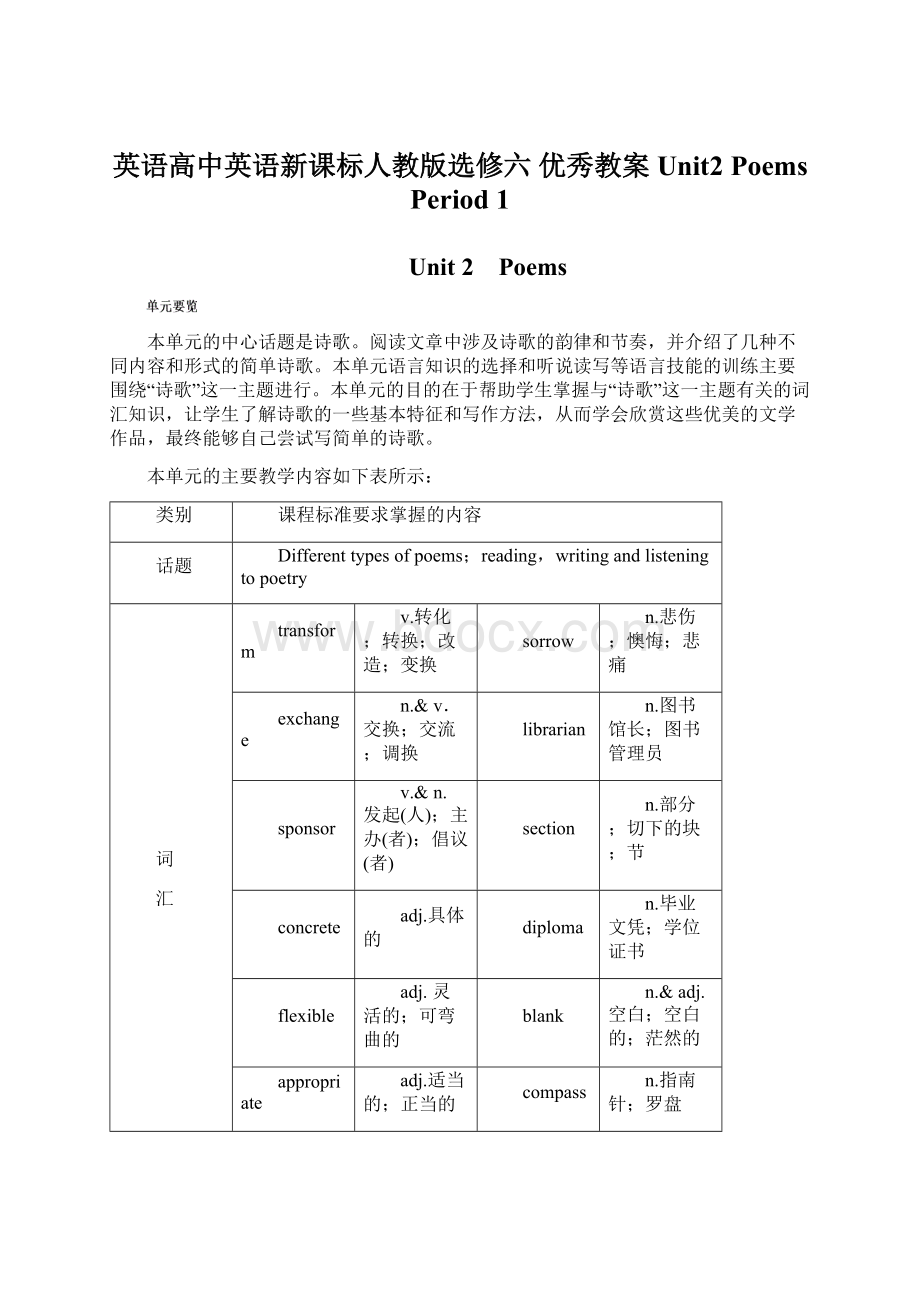英语高中英语新课标人教版选修六 优秀教案 Unit2 Poems Period 1.docx
《英语高中英语新课标人教版选修六 优秀教案 Unit2 Poems Period 1.docx》由会员分享,可在线阅读,更多相关《英语高中英语新课标人教版选修六 优秀教案 Unit2 Poems Period 1.docx(19页珍藏版)》请在冰豆网上搜索。

英语高中英语新课标人教版选修六优秀教案Unit2PoemsPeriod1
Unit2 Poems
本单元的中心话题是诗歌。
阅读文章中涉及诗歌的韵律和节奏,并介绍了几种不同内容和形式的简单诗歌。
本单元语言知识的选择和听说读写等语言技能的训练主要围绕“诗歌”这一主题进行。
本单元的目的在于帮助学生掌握与“诗歌”这一主题有关的词汇知识,让学生了解诗歌的一些基本特征和写作方法,从而学会欣赏这些优美的文学作品,最终能够自己尝试写简单的诗歌。
本单元的主要教学内容如下表所示:
类别
课程标准要求掌握的内容
话题
Differenttypesofpoems;reading,writingandlisteningtopoetry
词
汇
transform
v.转化;转换;改造;变换
sorrow
n.悲伤;懊悔;悲痛
exchange
n.&v.交换;交流;调换
librarian
n.图书馆长;图书管理员
sponsor
v.&n.发起(人);主办(者);倡议(者)
section
n.部分;切下的块;节
concrete
adj.具体的
diploma
n.毕业文凭;学位证书
flexible
adj.灵活的;可弯曲的
blank
n.&adj.空白;空白的;茫然的
appropriate
adj.适当的;正当的
compass
n.指南针;罗盘
eventually
adv.最后;终于
bride
n.新娘
tick
v.给……标记号
bridegroom
n.新郎
convey
v.传达;运送
championship
n.冠军称号
tease
v.取笑;招惹;戏弄
darkness
n.黑暗;漆黑
rhyme
n.&v.韵;(使)押韵
warmth
n.暖和;温暖
nursery
n.托儿所
scholarship
n.奖学金;学问;学术成就
diamond
n.钻石;菱形
pianist
n.钢琴家;钢琴演奏者
pattern
n.模式;式样;图案
violinist
n.小提琴演奏者
cottage
n.村舍;小屋
load
n.负担;负荷物
sparrow
n.麻雀
contradictory
adj.引起矛盾的;好反驳的
minimum
n.最低限度;最少量;最小数
salty
adj.含盐的;咸的
translation
n.翻译;译文
endless
adj.无穷的;无止境的
branch
n.枝条;支流;部门
forever
adv.永远
词
汇
takeiteasy轻松;不紧张;从容
bepopularwith很受欢迎
runoutof用完
translate...into...把……翻译成……
bemadeupof由……构成
stay/situp熬夜
tryout测试;试验
(sb./sth.)belikelytodosth.有可能……
letout发出;放走
lookforwardto盼望
inparticular尤其;特别
bychance/accident碰巧
句
型
1.Listpoemshaveaflexiblelinelengthandrepeatedphraseswhich_give_both_a_pattern_and_a_rhythm_to_the_poem.(theattributiveclause)
2.Wewould_have_wonifJackhad_scoredthatgoal.(thesubjunctivemood)
3.Anothersimpleformofpoemthatstudentscaneasilywriteisthecinquain,apoemmade_up_of_five_lines.(pastparticipleastheattributive)
4.WhenIwasababy,mymotherused_toreadmenurseryrhymes.(usedtodosth.)
5.With_so_many_different_forms_of_poetry_to_choose_from,studentsmayeventuallywanttowritepoemsoftheirown.(with+object+objectivecomplement)
功
能
语
法
虚拟语气(SubjunctiveMood)
(2)
IfRobhadn'tinjuredhimself,wewouldhavewon.
Ifshehadstudiedharder,shewouldhavegotthediploma.
教
学
重
点
1.Getstudentstoknowaboutdifferenttypesofpoems,somepoeticdeviceslikerhythm,rhyme,repetition,soundpatternsandimagery.
2.Havestudentslearnsomeusefulnewwordsandexpressionsaboutpoetryandletthemlearneffectivewaystomasterthem.
3.Enablestudentstograspandusetheexpressionsofintentionandplans.
4.Letstudentslearnthenewgrammaritem:
thesubjunctivemood
(2).
5.Developstudents'listening,speaking,readingandwritingability.
教学
难点
1.Enablestudentstomastertheuseofthesubjunctivemood.
2.Letstudentslearntocreatetheirownpoems.
3.Developstudents'integrativeskills.
课
时
安
排
Periodsneeded:
6
Period1 WarmingUp,Pre-reading,ReadingandComprehending
Period2 LanguageStudy
Period3 Grammar—theSubjunctiveMood
(2)
Period4 ListeningandSpeaking
Period5 ReadingandWriting
Period6 SummingUp,LearningTipandAssessment
Period1 WarmingUp,Pre-reading,
ReadingandComprehending
教学内容分析
Thisisthefirstteachingperiodofthisunit.ThecentralpartofthisperiodisthereadingpassagewiththenameofAFewSimpleFormsofEnglishPoemsshowingthestudentsafewkindsofsimpleEnglishpoems.
WarmingUpgivesthreequestionsforstudentstodiscusssothattheycanrecallanypoemstheyhaveeverlearnedandthinkaboutdifferentreasonswhypeoplewritepoems.
Pre-readingprovidesonequestionforstudentstothinkaboutandatableforstudentstofillinsoastohelpstudentsfocusonthetopicofthereadingpassageandleadthestudentstoskimthepoemsonthefollowingpagesandknowaboutthegeneralideaofthetext.
ReadingmainlyexplainsthereasonswhypeoplewritepoetryandintroducesfivesimpleformsofEnglishpoems.Nurseryrhymesarethefirstpoemsthatchildrenwillhear.Thesepoemsmaynotmakeanysensebuttheyareeasytolearnandrecite.Itisagoodwayforchildrentolearnaboutlanguage.Listpoemsoftenlistthings,usuallyhavingmanylines.Theyhaverepetitioninthemandsometimestheyhavewordsthatrhyme.Cinquainsareallmadeupoffivelinesandhavethefixedstructure.HaikuisaJapaneseformofpoetrythatismadeupof17syllables.Itisalmostlikeaphotoorpaintingasitcreatesastrongimageusingveryfewwords.TangpoemsarefamouspoemsfromAncientChina.Theyhavestrongimageryandareoftenaboutthebringingtogetherofopposites.
Comprehendingconsistsofthreegroupsofexercisesforthestudentstodosoastohelpthestudentstogetabetterunderstandingofthetext,thatistosay,tohelptheteachertocheckhowmuchthestudentshaveunderstoodthetext.
三维目标设计
Knowledgeandskills
1.Toknowthemeaningsofthefollowingnewwordsandphrases:
tick(给……标记号),rhyme(韵;押韵),convey(传达;运送),nursery(托儿所),concrete(具体的),contradictory(引起矛盾的;好反驳的),diamond(钻石;菱形),flexible(灵活的;可弯曲的),pattern(模式;式样;图案),cottage(村舍;小屋),sparrow(麻雀),takeiteasy(轻松;不紧张;从容),runoutof(用完),bemadeupof(由……构成),tease(取笑;招惹;戏弄),salty(含盐的;咸的),endless(无穷的;无止境的),minimum(最低限度;最少量),translation(翻译;译文),branch(枝条;支流;部门),inparticular(尤其;特别)
2.TolearnaboutsomesimpleformsofEnglishpoems.
3.Todevelopthestudents'readingabilitybyskimmingandscanningthepassage.
4.Todevelopthestudents'speakingabilitybytalkingaboutsomefeaturesofsomesimpleformsofEnglishpoems.
Processandmethods
1.WhiledoingWarmingUptheteachercanaskthestudentstothinkbackandtrytorememberpoemsfromboththeirearlychildhoodandmorerecentyears.AskstudentstocompleteExercise1ingroups.Askthemwhattheynoticeaboutthesepoems,thengetstudentstoreciteanypoemsorpartsofpoemstheycanremembersoastoarousetheirinterestinstudyingthewholeunit.
2.DuringPre-readingtheteachercangoaroundtheclassroomanddiscussthequestionswithseveralstudents.Thisdiscussionshouldbestudent-centeredandarousestudents'interestinEnglishpoetry.TheteachershouldalsoaskthestudentstoskimthetextsoastoletthemhaveageneralknowledgeofsomesimpleformsofEnglishpoems.
3.WhiledoingReadingandComprehending,theteachermayfirsthavethestudentsclosetheirbooksandlistentothetextwiththeireyesclosed.Thisgivesthestudentstheopportunitytolistentothesoundsor“music”ofthepoemsbeforereadingtheminmoredetail.Thenaskthestudentstoreadthetextquicklytogetthegeneralideaofthepassage.Afterdetailedreadingofthepassage,studentsareencouragedtoanswersomequestionsanddiscussthefeaturesofeachkindofthepoems.
4.Toconsolidatethecontentsofthereadingpassage,thestudentsshouldberequiredtoretellthefivekindsofpoemsintheirownwordsattheendoftheclass.
Emotion,attitudeandvalue
1.Tocultivatestudents'appreciationofpoetryandtheabilityofunderstanding,enjoyingandwritingpoems.
2.Todevelopstudents'senseofcooperativelearning.
教学重、难点
1.ToenablethestudentstolearnaboutsomesimpleformsofEnglishpoetryandtodeveloptheirreadingability.
2.Toenablethestudentstowritetheirownpoems.
Step1 Warmingup
1.VocabularyinReading
Matchthewordsandphraseswiththeirpropermeanings.
1.convey ( )A.samenessofsoundbetweenwordsorsyllables,esp.intheendoflines
2.cottage( )B.astrongfeelingsuchaslove,fearoranger
3.tease( )C.makefunofsomebodyinanunkindway
4.rhyme( )D.aplacewhereyoungchildrenarecaredfor
5.translate( )E.make(ideas,feelings,etc.)knowntoanotherperson
6.endless( )F.useup
7.nursery( )G.smallsimplehouse,esp.inthecountry
8.emotion( )H.relax
9.takeiteasy( )I.expresssth.inadifferentlanguage
10.runoutof( )J.withoutend
Suggestedanswers:
1.E 2.G 3.C 4.A 5.I 6.J 7.D 8.B 9.H 10.F
2.WarmingupbyaskingstudentstocompleteExercise1ingroups.Getthestudentstorecitethelittlepoemsandsongstheycanremember.Askthemwhattheynoticeaboutthesepoems.Forexample,perhapstheyhaveastrongbeat,ortheyrhyme,ortheyplaywithwordsandsounds,orperhapssomeofthemarefunnybecausetheymakenosense.
3.WarmingupbydoingExercise2withstudents.Thengetthemintogroupsasthismightprompttheirmemories.Getthestudentstoreciteanypoemsorpartsofpoemstheycanremember.(Ifthestudentscan'treciteanypoemsorpartsofpoems,prepareacoupleofpoemsthattheywouldknow,inChineseorEnglish.)
4.Tellstudentsthattherearemanyreasonswhypeoplewritepoetry.GivetheexamplesinExercise3.Askstudentsthereasonstheythinkthepoetswrotethepoemstheyhavejustrecited.Writetheirsuggestionsontheblackboard.
Step2 Pre-reading
1.Matchthefollowinginformation.
DuFu TangDynasty
FanZhongyanSongDynasty
MengHaoranModern
GuoMoruoModern
XuZhimoTangDynasty
ByronAmerica
ShellyEngland
WhitmanEngland
TagoreIndia
Suggestedanswers:
DuFu:
TangDynasty;FanZhongyan:
SongDynasty;MengHaoran:
TangDynasty;GuoMoruo:
Modern;XuZhimo:
Modern;Byron:
England;Shelly:
England;Whitman:
America;Tagore:
India
2.AskstudentstodoExercise1ingroups.Getthemtotelltheclasstheirfavouritepoemsandthereasons.Thismightbesomethingtheyfindhardtoarticulateasthepoemmightjustgivethemaspecialfeelingthat'shardtotalkabout.Ortheymightsaythingslike:
Itmakesmefeelsad.Ilikethesoundsinit.Ilikeitslanguage,it'sfunny,andmymotherusedtoreciteittome...
3.ThepurposeofExercise2istopracticeanimportantreadingskill:
scanningatext,thatis,lookingthroughatextquicklytofindspecificinformation.
Suggestedanswers:
Whichpoem
A
B
C
D
E
F
G
H
describesaperson?
√
tellsastory?
√
describesanaspectofaseason?
√
√
√
is